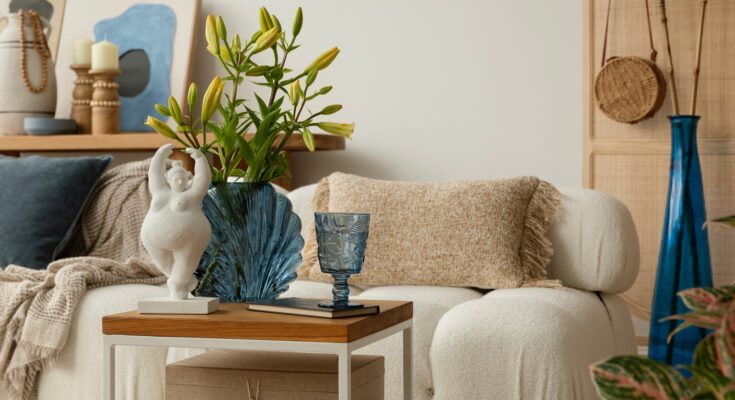Midimalism: The Design Trend You’ll Want In Your Space (And The Pattern Rule You Need To Follow)
When you think about design, you may have described your personal aesthetic as having elements of either minimalism or maximalism. But what about those who consider their style to be a middle ground, as an eclectic minimalism of sorts? Midimalism, a newer design concept, draws inspiration from concepts of minimalism and maximalism, balancing the functional elements of minimalism and maximalism’s hallmark ornate designs. The result is a cohesive blend of clean lines, bold accents, and meaningful pieces that reflect the individual.
In order to understand midimalism, it’s good to think of it as a concept. Midimalism aims to connect you with your environment through mindful curation and personalization without discouraging consumption. Instead, it takes from the thoughtfulness of choosing decorative pieces, furniture, and styling choices that are long-lasting and significant to your personality. As a design, it implements these fundamental principles, approaching both minimalist elements —its clean lines, simplicity, and functionality of storage and open spaces — with a maximalist interior — layered textures, eclectic features, and sentimentality — without veering too far into one extreme.
Key differences between minimalism, maximalism, and midimalism
Minimalism, as a concept, embraces simplicity. sustainability, and favors deliberate decor and functional spaces. The golden rule that a minimalist follows is the “less is more” maxim, promoting intentional living and mindful consumerism by only purchasing what’s necessary. If something doesn’t serve a purpose in a room, or at all, then you probably won’t find it in many minimalist spaces. On the other hand, maximalism embraces opulence and self-expression. For a maximalist, it’s all about drama! The concept is fully reflected in the larger-than-life expression of the individual, encouraging excess and indulgence. It’s about embracing one’s complexity while celebrating the sentimental value of things they own.
From a design perspective, minimalism relies on natural materials, neutral tones, and modern fixtures to relay functionality. Think soft, subtle textures, bare walls, and natural materials. Maximalism, however, incorporates rich, bold colors, patterns, and vintage pieces. When nailing the maximalist aesthetic, though, it requires adorning spaces with texture, such as velvet and embroidered, opulent decor.
Without being overly practical or too over the top, midimalism design respects the polarizing fundamentals of both minimalism and maximalism. Midimalism recognizes necessity and function while also maintaining the importance of personalization and self-expression. It encourages mindful ornamentation, allowing those spaces to serve as a reflection of their personality.
How to employ midimalism in your home
The key to midimalism is to achieve harmony between these two concepts. Since midimalism is about mindful consumption, it’s worth noting the longevity and sustainability of decorative pieces. That can look like thinking twice about purchasing another decorative bowl or researching the best kinds of furniture to thrift.
Your decor should reflect value that is both authentic to the individual’s unique style, while also serving a necessary role in the home. Mixing subtle colors with patterns is a great way of executing midimalism. Incorporating neutral tones on your walls can soften up the vibrant patterns and textures of certain furniture pieces. Likewise, large-scale wallpaper in a living room can lie cohesively against neutral-colored, simple seating.
Another way to incorporate midimalism is by adding statement art and decorative pieces to liven up a neutral space. A bedroom that seems bare can be evened out with unique and bold statement pieces, such as a gallery wall or a large standing mirror with an opulent gold frame. Layering textures can be a more subtle way of embracing midimalism. Play around with colors and blend plain quartz countertops with jade colored herringbone backsplashes in the kitchen, for example, or add a bold accent color to crown mouldings.


